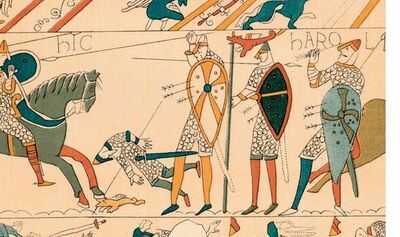

have made a stunning breakthrough after discovering an 11th Centry medieval toilet that has helped to unravel a 2,000-year-old mystery.
Researchers from the University of Exeter and the University of Newcastle believe they have uncovered Harold Godwinson, the last Saxon king of England's long-lost residence.
Experts had until now been unable to pinpoint the exact location of King Harold's residence in Bosham.
Illustrations of the grand hall in his residence appear twice in an 11th-century embroidered work known as the Bayeux Tapestry, which depicts events leading up to the 1066 Norman Conquest of England.
The tapestry shows Harold feasting in a grand hall before sailing to France. While the church in Bosham still stands today, experts have been left baffled by the hall's exact location.

However, researchers' re-examining evidence found in 2006 by West Sussex Archaeology led to a stunning revelation.
The initial 2006 investigation located two previously unidentified medieval structures at the site.
One structure is built into a modern-day private residence, and the other was found in the property's garden.
Dr. Duncan Wright, Senior Lecturer in Medieval Archaeology at Newcastle University and project leader, said a toilet from the period found in the building offered a vital clue.
While having a toilet in your home is practically a given in every household today, they were typically only found in high-status and elite residences in England during the 10th and 11th centuries.
He said: "The realisation that the 2006 excavations had found, in effect, an Anglo-Saxon en-suite confirmed to us that this house sits on the site of an elite residence predating the Norman Conquest.
"Looking at this vital clue, alongside all our other evidence, it is beyond all reasonable doubt that we have here the location of Harold Godwinson's private power center, the one famously depicted on the Bayeux Tapestry."
The team used geophysical surveys and historical analysis to come to its conclusion.
Professor Oliver Creighton from the University of Exeter said: "The Norman Conquest replaced England's Anglo-Saxon elite with a new ruling class, leaving few physical traces of their predecessors. Discoveries like this are hugely significant, as they offer a rare glimpse into the architectural and cultural identity of Anglo-Saxon aristocracy."
The experts wrote in the conclusion of their Where Power Lies sutdy that the finds show a remarkable level of consistency that provides a window into the priorities of England's newly emerging and increasingly power-conscious elite."